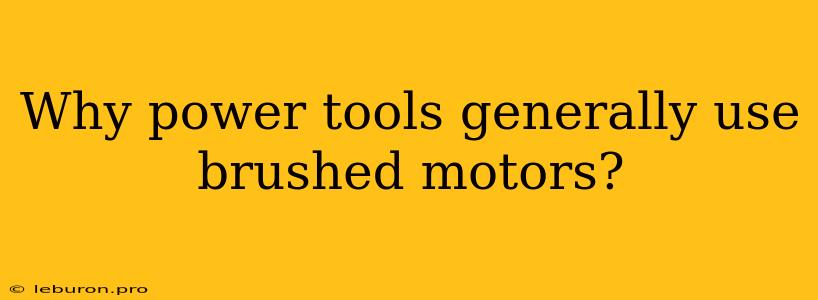Power tools have become indispensable in countless industries and workshops, providing the power and efficiency needed for a wide range of tasks. While technology continues to evolve, many power tools still rely on brushed motors as their primary source of power. This is because brushed motors offer a compelling combination of features that make them well-suited for the demanding applications that power tools face. This article delves into the reasons why brushed motors remain prevalent in power tools despite advancements in motor technology.
The Advantages of Brushed Motors in Power Tools
Brushed motors are a type of electric motor that uses brushes to transfer electrical current from the stationary part of the motor (stator) to the rotating part (rotor). This simple yet effective design has proven to be highly reliable and efficient in power tools, contributing to their widespread use.
1. Robustness and Durability
One of the primary reasons for the enduring popularity of brushed motors in power tools is their robust construction. The simple design with minimal moving parts makes them inherently durable and resistant to wear and tear. The brushes, while subject to wear, are readily replaceable, extending the motor's lifespan. This inherent robustness makes brushed motors ideal for handling the heavy-duty tasks often encountered in construction, woodworking, and other power tool applications.
2. High Starting Torque
For power tools, starting torque, the force that gets a tool moving from a standstill, is crucial. Brushed motors excel in this regard. The direct current (DC) nature of these motors allows for high starting torque, enabling power tools to quickly reach their operating speed and efficiently tackle tough materials. This is particularly important for applications like drilling, driving screws, and cutting, where a strong initial force is needed.
3. Affordable Cost
Brushed motors are generally more affordable to manufacture compared to brushless counterparts. This lower cost makes them an attractive option for manufacturers, particularly for budget-conscious power tool models. The affordability translates to lower consumer prices, making power tools more accessible to a wider range of users.
4. Easy Maintenance
Brushed motors are relatively easy to maintain. The brushes, which are prone to wear, are readily replaceable. Users can often replace brushes themselves, reducing downtime and maintenance costs. The simple design also allows for straightforward troubleshooting and repairs, further enhancing the motor's practical appeal.
Limitations of Brushed Motors
While brushed motors offer several advantages for power tool applications, they are not without limitations. Understanding these limitations helps to explain the gradual shift towards brushless motors in certain power tool segments.
1. Brush Wear and Maintenance
The most significant drawback of brushed motors is the wear and tear on the brushes. The constant friction between the brushes and the commutator (a part of the rotor) causes the brushes to wear down over time. This requires regular replacement, adding to the overall cost of ownership and maintenance.
2. Reduced Efficiency
Brushed motors have a slightly lower efficiency compared to brushless motors. The friction between the brushes and the commutator generates heat and results in some energy loss. This reduced efficiency can impact battery life in cordless tools.
3. Limited Speed Control
While brushed motors can provide good starting torque, controlling the speed can be more challenging. This is due to the inherent nature of the motor's operation, which relies on a fixed voltage and current.
4. Electrical Noise
Brushed motors can generate electrical noise due to the sparking between the brushes and the commutator. This noise can be a concern in sensitive applications or for users who prefer quieter operation.
The Rise of Brushless Motors
Despite the prevalence of brushed motors in power tools, brushless motors are gaining traction in certain segments due to their advantages in speed control, efficiency, and durability. Brushless motors use electronic commutation instead of mechanical brushes, eliminating the wear and tear associated with brushes. This results in higher efficiency, longer lifespan, and quieter operation. However, brushless motors are generally more expensive to manufacture, limiting their use in budget-conscious power tool models.
Conclusion
Brushed motors remain a cornerstone of power tool design due to their robustness, affordability, and reliable performance. Their simple design, high starting torque, and ease of maintenance make them well-suited for a wide range of tasks, particularly those requiring heavy-duty operation. As technology advances and brushless motors become more cost-effective, their adoption is likely to increase, particularly in applications where efficiency, speed control, and reduced noise are critical. However, brushed motors will likely continue to dominate the power tool market for the foreseeable future, providing a reliable and cost-effective solution for many users.
